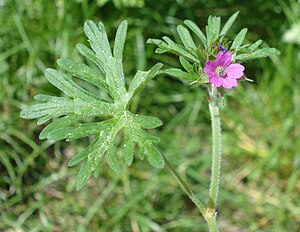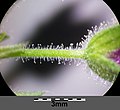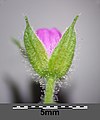Slit-leaved cranesbill
| Slit-leaved cranesbill | ||||||||||||
|---|---|---|---|---|---|---|---|---|---|---|---|---|

Slit-leaved cranesbill ( Geranium dissectum ) |
||||||||||||
| Systematics | ||||||||||||
|
||||||||||||
| Scientific name | ||||||||||||
| Geranium dissectum | ||||||||||||
| L. |
The laciniate cranesbill ( Geranium dissectum ) is an annual plant from the family of geraniaceae .
description
The slit-leaved cranesbill is usually an annual , more rarely a biennial plant . It has a taproot and reaches heights of 10 to 40, rarely 60 cm. The stems are ascending to erect and branched. Like the petioles, they are covered with backward-facing, protruding hairs that are 0.5 to 1 mm long and occasionally glandular.
The rosette of the basal leaf is usually already dried up before flowering. The stem leaves are opposite, their petiole 1 to 9 (rarely 13) cm long. The leaf blade is 2 to 4 (rarely up to 9) cm wide and five to seven-lobed almost to the base. The sections are two to four columns. The stipules are lanceolate and pointed.
The partial inflorescences are two-flowered and have 0.5 to 3 (rarely 5) cm long stems, which are usually shorter than the bracts. The flower stalks are 0.5 to 1.5 cm long. Both stalks and the sepals are densely covered with glandular hairs 0.2 to 0.8 mm long. The flowers are small with a maximum diameter of 1.5 cm. The sepals are 5 to 8 mm long, carry a 0.5 to 1.5 mm long awn , which elongates at the fruiting time. The petals are 5 to 6 (rarely 8) mm long, of red-violet color. They are edged or incised at the tip, the nail is hairy. The stamens are maximally as long as the petals.
The fruit is a desiccant spreader . It is hairy glandular, including beak (13 to) 15 to 18 mm long. The fruit flaps are 3 mm long, the fruit beak 7 to 12 mm. The seeds are smooth and dotted with pits.
The number of chromosomes is 2n = 22.
Distribution and locations
The slit-leaved cranesbill is native to Europe and is also found in western Asia. Its area is meridional to temperate and oceanic. In Central Europe it is an archaeophyte , in Germany it is widespread, but rarely in the north.
It grows in fields, on roadsides and in gardens. In Central Europe it occurs particularly on fresh to moderately dry, nutrient-rich loamy soils. It is a decidedly clay pointer. It is a Fumario-Euphorbion-Verband character type in Central Europe .
It grows from the Kollinen to the montane altitude , in Upper Austria it rises to around 1000 m. In the Allgäu Alps, it rises in Bavaria in the Hintersteiner Tal near the gable house to 1200 m above sea level.
literature
- Rudolf Schubert , Klaus Werner, Hermann Meusel (eds.): Excursion flora for the areas of the GDR and the FRG . Founded by Werner Rothmaler. 13th edition. tape 2 : vascular plants . People and knowledge, Berlin 1987, ISBN 3-06-012539-2 (area).
- Siegmund Seybold (Ed.): Schmeil-Fitschen interactive . CD-ROM, version 1.1. Quelle & Meyer, Wiebelsheim 2002, ISBN 3-494-01327-6 .
Individual evidence
- ↑ a b Erich Oberdorfer : Plant-sociological excursion flora for Germany and neighboring areas . With the collaboration of Angelika Schwabe and Theo Müller. 8th, heavily revised and expanded edition. Eugen Ulmer, Stuttgart (Hohenheim) 2001, ISBN 3-8001-3131-5 , pp. 626 .
- ↑ Erhard Dörr, Wolfgang Lippert : Flora of the Allgäu and its surroundings. Volume 2, IHW, Eching 2004, ISBN 3-930167-61-1 , p. 170.
Web links
- Slit-leaved cranesbill. In: FloraWeb.de.
- Slit-leaved cranesbill . In: BiolFlor, the database of biological-ecological characteristics of the flora of Germany.
- Profile and distribution map for Bavaria . In: Botanical Information Hub of Bavaria .
- Geranium dissectum L. In: Info Flora , the national data and information center for Swiss flora .
- Distribution in the northern hemisphere from: Eric Hultén, Magnus Fries: Atlas of North European vascular plants. 1986, ISBN 3-87429-263-0 at Den virtuella floran. (Swedish)
- Thomas Meyer: Data sheet with identification key and photos at Flora-de: Flora von Deutschland (old name of the website: Flowers in Swabia )






